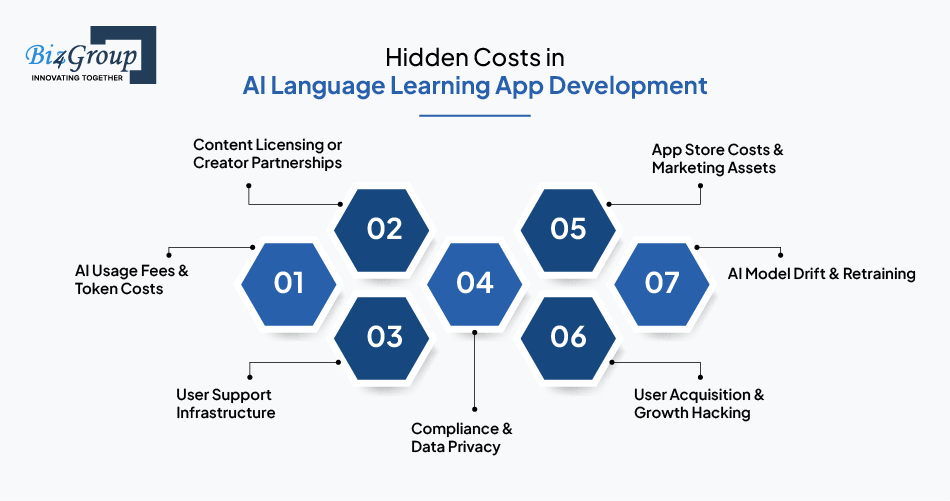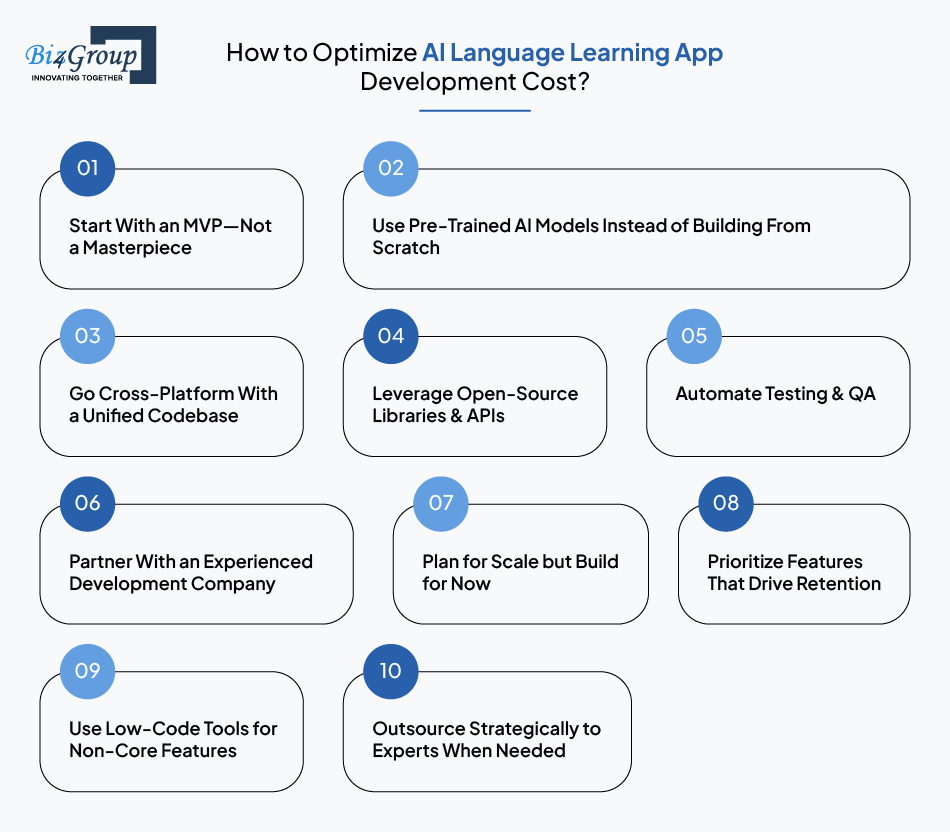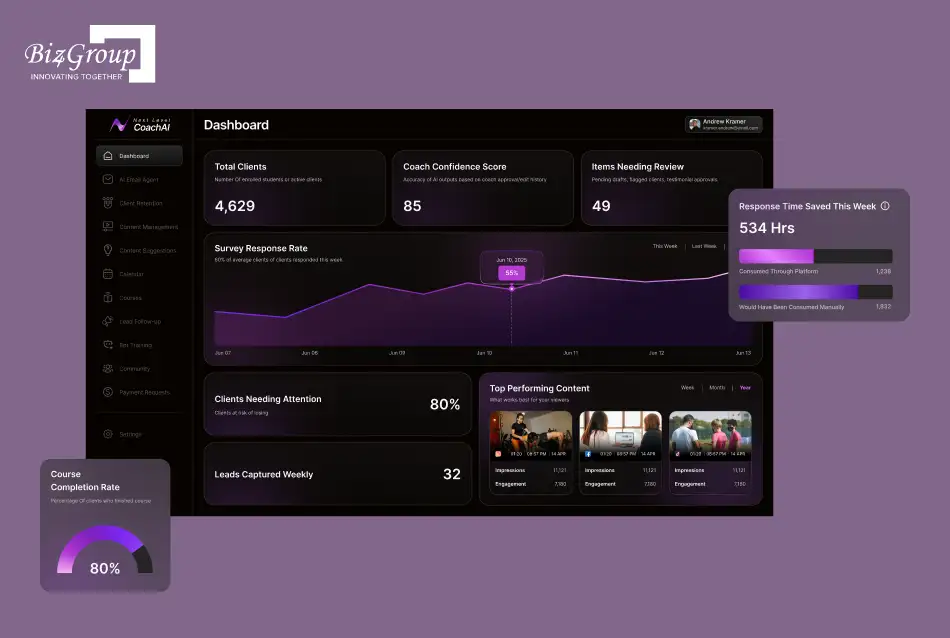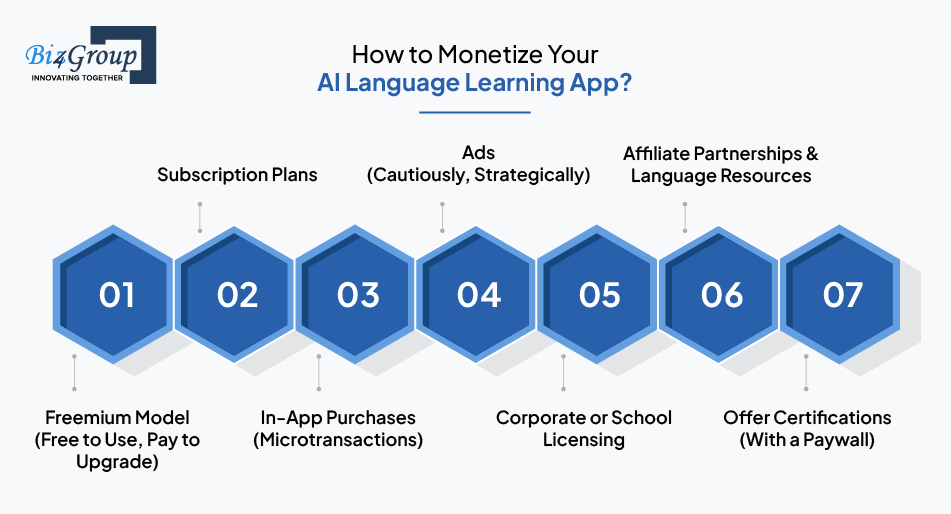Basic AI Chatbot Pricing: A simple chatbot that can answer questions about a product or service might cost around $10,000 to develop.
Read More

Someone out there is building the next big AI language app right now, and if it’s not you, it might just be your future competition.
Welcome to the EdTech boom, where language learning has officially graduated from dusty textbooks to intelligent apps that talk back, adapt, and don’t judge your accent (much).
According to market data, the global EdTech industry is set to skyrocket from $163.49 billion in 2024 to over $348 billion by 2030.
That’s growth.
With North America owning more than 35% of the market and the business sector leading in adoption, there’s no shortage of opportunity (or competitors).
If you’re a startup, product lead, investor, or the kind of entrepreneur who’s been mentally designing app screens in the shower, this is your moment.
Because learners today have no patience for clunky interfaces, robotic voices, or cookie-cutter grammar lessons.
They want real-time feedback. Smart recommendations. A learning journey that feels like it was built just for them.
And honestly? With today’s tools, it can be.
Here’s why the timing couldn’t be better:
The demand isn’t trending, it’s exploding
From professionals upskilling to travelers brushing up, millions are learning new languages on mobile.
Duolingo alone has racked up 83 million active users, and they’re not the only game in town.
AI makes hyper-personalization a breeze
With pre-trained models and real-time speech processing, even niche learning paths (like “Korean for K-pop fans”) are within reach and within budget.
Building smart is cheaper than ever
You don’t need a Google-sized R&D team. APIs, open-source frameworks, and low-code tools have made intelligent mobile app development shockingly accessible.
The market isn’t full, it’s fragmented
The demand is global, but the offerings are still catching up.
You’ve got room to niche, innovate, and own your slice of the pie.
Businesses want in too
The largest revenue share in EdTech isn’t just students—it’s businesses. Companies are investing in smarter employee training and language onboarding tools.
This opens new doors for any e-learning app development company looking to serve both B2C and B2B markets with scalable, AI-driven solutions.
In short? The audience is primed, the tech is ready, and the runway is clear. All that’s left is your big idea and a plan to build it without breaking the bank.
For a deeper look at the process, tech stack, and strategic steps involved, check out our guide to AI language learning app development.

Ever tried budgeting for a new app and felt like you were throwing darts at a dartboard... blindfolded... during an earthquake?
You're not alone.
So, how much does building an AI language learning apps really cost?
Short answer: somewhere between $40,000 and $300,000+, depending on what bells, whistles, and AI wizardry you want.
Here’s the long (and much more useful) answer.
Because users don’t care where they learn, they just want it to work everywhere.
| Platform | Details | Estimated Cost |
|---|---|---|
|
iOS Only |
Swift-based development, App Store integration |
$15,000 – $30,000 |
|
Android Only |
Java/Kotlin development, Play Store setup |
$15,000 – $30,000 |
|
Cross-Platform (Flutter, React Native) |
Shared codebase, reduces effort |
$25,000 – $45,000 |
|
Web Version |
Responsive, often paired with mobile |
$10,000 – $20,000 extra |
Cross-platform = less duplication, faster deployment, and happier developers (mostly).
The features users interact with daily—aka the things they’ll blame if they don’t become fluent.
| Feature | Description | Cost Range |
|---|---|---|
|
User Registration & Profiles |
Login, preferences, progress tracking |
$3,000 – $7,000 |
|
Lesson Content Delivery |
Multimedia lessons (text, audio, video) |
$5,000 – $15,000 |
|
Flashcards & Quizzes |
Core learning interaction tools |
$4,000 – $10,000 |
|
AI-Powered Chatbot |
NLP-based conversational assistant |
$10,000 – $25,000 |
|
Real-Time Speech Recognition |
Pronunciation feedback using AI |
$15,000 – $35,000 |
|
Progress Tracking |
Personalized dashboards & metrics |
$4,000 – $8,000 |
|
Push Notifications |
Engagement, lesson reminders |
$2,000 – $5,000 |
|
Gamification |
Points, badges, leaderboards |
$5,000 – $12,000 |
Gamify it or wave goodbye to your user retention.
Where the magic (and a fair bit of money) happens.
| AI Feature | Tools/Models | Cost Estimate |
|---|---|---|
|
Pre-trained LLM Integration |
OpenAI, Anthropic, Cohere APIs |
$8,000 – $20,000 setup + usage fees |
|
Custom Model Training |
NLP fine-tuning for tone/language |
$25,000 – $60,000 |
|
AI Tutor Personalization |
Behavior tracking, adaptive responses |
$10,000 – $25,000 |
|
Text-to-Speech/Speech-to-Text |
Google Cloud Speech, Amazon Polly |
$10,000 – $30,000 |
|
Context-Aware NLU |
Intelligent response generation |
$12,000 – $30,000 |
Want your app to sound smart, natural, and just a little sassy? Budget for it.
And to stitch all these AI-powered parts together seamlessly, expert AI integration services can save you hours of trial-and-error, and a few existential dev crises.
Because even the smartest AI can’t teach you what it doesn’t know.
| Content Type | Scope | Estimated Cost |
|---|---|---|
|
Curriculum & Lesson Plan Design |
Framework for structured learning |
$5,000 – $15,000 |
|
Voiceovers & Audio Content |
Native speaker recordings, pronunciation guides |
$3,000 – $10,000 |
|
Video Production |
Explainers, cultural content, intros |
$5,000 – $15,000 |
|
Localization |
Translation + cultural adaptation |
$500 – $2,000 per language |
Multilingual users expect content that speaks their language—and doesn’t butcher it.
Because if it looks like it was built in 2011, no one’s sticking around in 2025—and that’s where a seasoned UI/UX design company can make all the difference.
| Design Level | What’s Included | Cost Estimate |
|---|---|---|
|
Basic |
Template-based UI, limited screens |
$3,000 – $5,000 |
|
Mid-Level |
Custom screens, light animation, responsive UX |
$6,000 – $12,000 |
|
High-End |
Gamified UX, transitions, adaptive layout |
$12,000 – $25,000 |
A beautiful UX doesn’t just impress users. It’s what keeps them coming back instead of ghosting your app like an old language partner.
Also Read: Top 15 UI/UX Design Companies in USA
Where all the heavy lifting happens—quietly, powerfully, and ideally, without crashing.
| Infrastructure Component | Description | Cost Range |
|---|---|---|
|
Server Setup & APIs |
Business logic, integration layer |
$7,000 – $15,000 |
|
Cloud Hosting (AWS/GCP) |
Storage, compute for AI inference |
$500 – $3,000/month |
|
Database Management |
User data, performance, media content |
$4,000 – $8,000 |
|
Security & Compliance |
GDPR, FERPA (for EdTech), encryption |
$3,000 – $8,000 |
Think of it as plumbing. No one notices until it breaks, and then it's all they notice.
Unless you’re a one-person code-slinging unicorn (and even then), you’ll need help.
| Role | Estimated Monthly Cost | Needed For |
|---|---|---|
|
Project Manager |
$4,000 – $7,000 |
Timeline, scope, coordination |
|
Frontend Developer |
$4,000 – $8,000 |
Interface development |
|
Backend Developer |
$5,000 – $10,000 |
Server, API logic |
|
AI/ML Engineer |
$6,000 – $12,000 |
Model integration, tuning |
|
UI/UX Designer |
$3,000 – $6,000 |
Wireframes, experience design |
|
QA Engineer |
$2,000 – $5,000 |
Bug testing, user flow validation |
|
DevOps |
$3,000 – $6,000 |
Deployments, scalability, CI/CD |
The right team saves time, money, and at least 47 headaches.
You could build everything from scratch, but why would you when smarter tools already exist?
| Integration | Purpose | Cost Estimate |
|---|---|---|
|
Payment Gateway (Stripe, PayPal) |
In-app purchases, subscriptions |
$2,000 – $5,000 |
|
Analytics Tools (Mixpanel, GA4) |
User behavior tracking |
$1,000 – $3,000 |
|
CRM or Email Automation |
Lead nurturing, user re-engagement |
$2,000 – $4,000 |
|
Translation APIs |
Google Cloud Translate, DeepL |
$1,000 – $3,000 setup + usage |
Great apps don’t just teach—they sell, scale, and self-optimize.
Because “Set it and forget it” doesn’t work with real users (or AI).
| Maintenance Task | Frequency | Annual Cost Estimate |
|---|---|---|
|
Bug Fixes & Updates |
Monthly |
$8,000 – $15,000/year |
|
AI Model Updates |
Quarterly or as needed |
$5,000 – $20,000/year |
|
Security Patching |
Ongoing |
$3,000 – $7,000/year |
|
Feature Enhancements |
Per roadmap |
Variable |
Your app won’t need constant hand-holding, but it will need consistent check-ins—and a few performance pep talks.
So, what’s the price tag?
Whether you’re going for a lean MVP at $40K or a full-featured, scalable platform tipping $300K+, the key is knowing what you need and what you can launch later.
Let’s trim the fat, not the features. We’ll help you build smarter, not just costlier.
Let’s Talk NumbersComing up next are the hidden costs of AI app development.
(aka, the budget gremlins that sneak up while you're busy building the next big thing in EdTech)
You’ll definitely want to stick around for this one.

Because budgets have a funny way of expanding when no one’s watching.
Think your estimate is locked in? Think again.
The development cost of an AI language learning app isn’t just about features, AI models, or hosting. It’s also about the sneaky stuff that slips through during planning and shows up uninvited on your invoice.
Here’s what most product teams don’t account for (but absolutely should):
AI doesn’t just work—it bills you by the word.
Using OpenAI, Anthropic, or similar services may sound affordable at first, but token-based pricing can scale quickly.
| Item | Cost |
|---|---|
|
API Usage |
$0.003 to $0.06 per 1,000 tokens |
|
Average Monthly Use (per 10K users) |
$1,000 – $4,000/month |
|
Fine-tuning Custom Models |
$5,000 – $15,000 one-time |
If your app talks a lot, it’ll also cost a lot.
That amazing native speaker voice? Not free.
If you're sourcing content, translations, or partnering with language instructors or linguists, prepare for additional spend.
| Expense | Estimated Cost |
|---|---|
|
Licensed Content |
$500 – $5,000 per module |
|
Partnership Revenue Share |
10% – 25% of content sales |
|
Voiceover Buyouts |
$200 – $2,000 per language |
AI can synthesize voices, but human content still adds credibility and character.
Someone has to answer the "Why won’t it save my progress?" emails.
As your app scales, so does the need for support—live chat, ticketing, or AI-powered customer service chatbots that answer FAQs before humans need to.
| Tool/Service | Monthly Cost |
|---|---|
|
Chatbots & Helpdesk (e.g., Zendesk, Intercom) |
$100 – $1,000/month |
|
Human Support Team (contract/freelance) |
$1,500 – $6,000/month |
Proactive support = fewer bad reviews, more happy users.
Especially if your app collects voice, biometric data, or targets kids.
Failing to meet standards like GDPR, COPPA, or FERPA could cost you more than development.
| Item | Estimated Cost |
|---|---|
|
Legal Consultation |
$3,000 – $10,000 |
|
Compliance Implementation |
$5,000 – $12,000 |
|
Ongoing Monitoring & Audits |
$2,000 – $5,000/year |
No one wants to go viral for a privacy breach.
Getting approved is half the battle.
Getting noticed? That’s the other half.
Even after launch, publishing and visibility come with price tags.
| Item | Cost |
|---|---|
|
App Store Registration |
$99/year (Apple), $25 one-time (Google) |
|
Store-Ready Screenshots, Icons, Videos |
$1,000 – $3,000 |
|
A/B Testing Launch Assets |
$500 – $2,000 per variation |
Polished visuals = more downloads.
Ugly previews = digital tumbleweeds.
If you build it, they won’t come, unless you tell them to.
Whether it's SEO, paid ads, or influencer campaigns, early-stage user acquisition needs a budget.
| Channel | Typical Budget Range |
|---|---|
|
Paid Ads (Meta, Google, TikTok) |
$3,000 – $15,000/month |
|
App Store Optimization |
$1,000 – $3,000 setup |
|
Influencer Collaborations |
$500 – $5,000 per post/campaign |
Organic growth is great.
Controlled growth is better and faster.
Even smart models lose their touch over time.
In fact, staying updated on innovations like generative AI in education can help you plan better model updates and engagement strategies.
User queries change, slang evolves, and model performance can degrade.
Retraining and updating are essential.
| Task | Frequency | Cost |
|---|---|---|
|
Model Fine-tuning |
Bi-annually or as needed |
$5,000 – $20,000/year |
|
Evaluation & Testing |
Quarterly |
$1,000 – $3,000/year |
Even AI needs to study sometimes.
Our thoughts:
Think of these costs as the “fine print” of AI app development.
They’re not there to scare you. They’re there to prepare you.
Because smart founders and product teams don’t just budget for development—they budget for the business of building.
Yeah, the budget gremlins are real—but we know how to keep them in check.
Talk to Our ExpertsBecause sometimes, the best way to think big… is to see who already did.
Let’s take a peek behind the curtain of five of the most iconic language learning apps of our time.
These are practically your blueprints with budgets.
We’ll break down their standout features, market strengths, and what it probably cost to get them off the ground.
The green owl that guilt-trips you into fluency.
Duolingo is the reigning king of gamified language learning.
With over 83 million monthly active users, it’s available in 40+ languages and used by learners, schools, and even enterprises.
Core Features:
Estimated Development Cost:
$300,000 – $600,000+ (initial MVP)
$1M+ ongoing feature expansion, AI R&D, and global scaling
Fun Fact:
Duolingo’s mascot has become a meme.
When your brand becomes a running joke on the internet (in a good way) you’ve officially made it.
Think: Duolingo’s serious older sibling with a passport and perfect pronunciation.
Focused more on real-world conversational fluency, Babbel delivers professionally crafted lessons by language experts.
It appeals to travelers, professionals, and users looking for practical language use.
Core Features:
Estimated Development Cost:
$250,000 – $500,000+ (initial version)
$2M+ for content production, live support, and AI tutoring tools
Fun Fact:
Babbel claims 73% of users improve their speaking confidence within five hours of use. That’s less time than your average binge-watch session.
The OG of digital language learning and still holding its own.
Rosetta Stone pioneered immersive learning with zero translations.
It’s built on the idea that we can learn languages like we learned our first: with pictures, repetition, and no cheating with native language crutches.
Core Features:
Estimated Development Cost:
$400,000 – $800,000+ (legacy revamp)
Fun Fact:
Founded in 1992, Rosetta Stone is older than Google. Let that sink in.
Your pocket polyglot with a social twist.
Busuu blends AI learning paths with community-driven corrections.
Users can practice speaking and writing with real native speakers, making it part language app, part global pen-pal club.
Core Features:
Estimated Development Cost:
$200,000 – $400,000 (initial launch)
$1.5M+ including AI models and peer-review infrastructure
Fun Fact:
Busuu is named after a nearly extinct language spoken by only 8 people in Cameroon. Cultural respect, level: max.
The app that turns language learning into a meme-fest (in the best way possible).
Memrise makes vocabulary unforgettable by mixing spaced repetition with humorous content, videos from real native speakers, and cultural context.
Core Features:
Estimated Development Cost:
$150,000 – $300,000 (initial version)
Fun Fact:
One of Memrise’s biggest user growth hacks? Humor.
Their quirky, sometimes absurd mnemonic techniques make learning actually fun.
Imagine that.
Saving $50K now could mean investing it in your marketing later or your app's next viral growth feature.
Speaking of which… ever wondered how to keep your development budget smart, flexible, and future-ready?
Let’s talk strategy.

Cutting costs without cutting corners? Totally possible.
Building an AI language learning app doesn’t have to feel like budgeting for a private rocket launch.
While premium features and smart integrations can rack up your invoice, there are plenty of ways to optimize the development cost without sacrificing innovation or user experience. If you're also comparing broader AI app development cost trends beyond language learning, this breakdown can give you some added perspective.
Here’s how smart teams (and smart founders) do it:
Build the essentials. Add the fancy stuff later.
You don’t need 37 features at launch.
Focus on your core value proposition—maybe it's adaptive learning, or fast-track speaking practice—and launch with just enough to prove traction. If you're unsure where to start, partnering with expert MVP development services can streamline the process.
Cost Impact:
Save 30–50% of initial development cost by phasing features across multiple releases.
Need help narrowing down your shortlist? Here’s a roundup of top MVP development companies in the USA to explore.
OpenAI, Google, and Cohere have already done the hard part.
Unless you’re launching a language app for aliens, there’s probably no need to build your own model.
Pre-trained LLMs offer fast, powerful language processing without massive dev hours and with the right AI integration services, you can get them up and running in record time.
Cost Impact:
Save $25,000–$60,000+ in model training and infrastructure.

One way we’ve seen AI costs optimized in practice is through Coach AI, an automation platform we built for coaches, educators, and digital creators.
Instead of training expensive, full-scale custom models from scratch, we combined pre-trained AI models with modular integrations across platforms like Kajabi, Thinkific, and social media. The result was an affordable yet powerful AI suite of specialized agents that:
By leveraging existing AI infrastructure and focusing custom development only where it mattered (like tone replication and analytics), we delivered a feature-rich, scalable solution without the $500K+ price tag you’d expect from a ground-up build.
The same approach applies to AI language learning apps, smart use of pre-trained models and targeted customizations can cut development costs by 30–50% while keeping the user experience world-class.
One build, two platforms. Because time is money.
Frameworks like Flutter or React Native let you build for both Android and iOS simultaneously.
It’s faster, cleaner, and reduces long-term tech debt.
Cost Impact:
Reduce dev time by 30–40%, and maintenance costs by up to 25%.
Why reinvent the wheel when you can use a perfectly good one for free?
Use open-source UI libraries, speech recognition tools, and NLP APIs where possible. They're battle-tested and community-supported.
Cost Impact:
Trim $5,000–$15,000 off your dev stack, depending on feature depth.
Because humans miss bugs and bots work 24/7.
Integrating automated testing frameworks early reduces long-term QA overhead and speeds up deployment.
Cost Impact:
Save 20–30% on QA resources in the long run.
The right team builds faster and smarter.
A seasoned development partner (yes, shameless plug: like Biz4Group) brings reusable components, time-tested workflows, and battle scars that prevent future budget disasters.
Cost Impact:
Avoid scope creep, miscommunication, and rework—easily saving $20,000–$50,000+ over the project lifecycle.
Don’t pay today for traffic you won’t get for six months.
Design your infrastructure to scale but only activate what’s needed for your current user base.
Cloud services let you ramp up when the demand hits; no need to prepay for future success.
Cost Impact:
Reduce cloud and infra costs by 40–60% in early stages.
What keeps users coming back? That’s where your money should go.
Focus your budget on what actually drives engagement: gamification, progress tracking, smart notifications.
Features that feel fun, not just functional.
Cost Impact:
Improves ROI on feature development and reduces churn-related losses.
Your users won’t see it and you don’t need to overspend on it.
Instead of custom-building every internal panel or analytics view, use low-code platforms like Retool, Bubble, or Firebase to handle the boring stuff quickly.
Cost Impact:
Save $3,000–$10,000. Great for MVPs and internal use cases.
Freelancers can be gold or costly chaos.
Use external experts for things like UI design, copywriting, or QA, but vet them thoroughly and avoid the lowest bidder trap.
Cost Impact:
You save $5,000–$15,000 compared to hiring full-time or dealing with bad freelancers.
Optimizing your AI language learning app development cost doesn’t mean settling for less. It means investing wisely, validating early, and scaling with confidence.
And if you're thinking, "This sounds great, but can someone just help me do it?"—you’re in luck. That's literally what we do.
You bring the vision. We bring the shortcuts that actually work.
Build With Us
Building an AI language learning app is one thing.
Making money from it? That’s where the real strategy kicks in.
The good news: your audience is already conditioned to pay for learning tools, especially if they’re smart, engaging, and help them finally pronounce “croissant” correctly.
Here are the most effective and scalable ways to turn your app into a revenue-generating machine:
Get them hooked. Then unlock the real value.
Let users start with basic features and lessons for free, then charge for premium content, smart features (like AI chatbots or pronunciation feedback), and ad-free experiences.
Why it works:
Great for early-stage growth, mass-market reach, and viral engagement.
Common Upsells:
Because recurring revenue is the holy grail.
Monthly, quarterly, or annual plans that unlock all features, content, or even live classes. This is how most top apps (yes, the big green owl included) make their money.
Why it works:
Price Range: $5 to $30/month (based on feature depth)
Pro Tip:
Bundle in features like daily reminders, AI-generated practice sets, or live support for perceived value.
Learning is free. Custom avatars, bonus lessons, and extra lives? That’ll be $1.99.
Offer consumables, upgrades, or aesthetic customizations to drive monetization from power users without locking critical learning behind a paywall.
Why it works:
Examples:
Monetize the free-tier users without annoying the loyal ones.
Integrate ads sparingly in the free version, like between lessons or on results screens, but give users a reason to upgrade (read: escape the ads).
Ad Options:
Revenue Potential: $0.50 to $3.00 eCPM (varies by region)
Pro Tip:
Don’t overdo it. Ads should be the seasoning, not the main dish.
B2B is where the big checks live.
Offer your platform to schools, universities, or corporations as a branded or white-label solution for language training or ESL support.
Why it works:
Potential Revenue: $10,000 – $100,000+/year per institution (depending on scale and customization)
Help users book tutoring, travel, or tests and earn while you do it.
Integrate links or upsells to external products—language certifications, tutors, travel programs, or language-related marketplaces, and earn commission.
Examples:
Why it works:
Recognition = motivation = monetization.
Let users earn certificates for completing levels or courses, especially valuable for career-focused learners and ESL students.
Charge a small fee for certification or assessments.
Revenue Model:
Bonus:
It makes your app feel more official and educationally legit.
In short, monetization isn’t about nickel-and-diming users. It’s about matching value to price and creating upgrade paths that feel natural, rewarding, and actually worth it.
When your product genuinely helps someone grow, they’ll gladly pay for the journey.
Let’s turn those lessons into leads, and learners into loyal subscribers.
Schedule a Free CallSo now that you know how to plan smart… want to know who can actually build it smart?
Big ideas don’t need bloated budgets. They need the right tech partner.
At Biz4Group, recognized as a top mobile app development company, we specialize in developing cost-efficient, scalable AI-powered language learning apps tailored for EdTech startups and enterprises. With years of hands-on experience in AI, EdTech, and custom enterprise AI solutions, we help startups and businesses like yours lower development costs while boosting long-term value.
Here’s how we make your AI language learning app development journey smarter, faster, and more budget-friendly:
We don’t do cookie-cutter.
Your app gets a bespoke build strategy, like what you'd expect from a custom AI EdTech software development company—carefully aligned with your audience, business goals, and budget limits. Whether you're building your first MVP or scaling, we help optimize the cost of AI language learning app development without compromising quality.
What that means for you:
No bloated codebases. No unnecessary features. No wasted spend
We’ve delivered powerful solutions using OpenAI, Google ML, and custom NLP pipelines across industries including education, healthcare, and enterprise—as a leading AI app development company with real-world experience in AI-powered language learning app development.
What that means for you:
Our agile workflow ensures your investment directly impacts progress. Through sprints, you get early access to working builds, real-time cost visibility, and continuous iteration. It's how we help control the development cost of your AI language app, without cutting corners.
What that means for you:
Whether you need a fixed-cost MVP or a full-scale rollout, we offer flexible models to suit your funding stage and timeline. Our approach is ideal for startups budgeting for an AI-based EdTech language application and enterprises seeking long-term scalability.
What that means for you:
We’re not done when your app hits the store. From post-launch monitoring to iterative upgrades and AI model tuning, we help manage long-term AI language learning app costs while maintaining performance and engagement.
What that means for you:
From Fortune 500 giants to rising EdTech startups, we’ve helped businesses create high-impact, cost-efficient AI apps. As a top software development company in the USA, we blend smart tech with strong ROI.
What that means for you:
If you’re serious about launching a cost-efficient AI language learning app that users love and investors respect, Biz4Group is the partner to help you do it right, from blueprint to breakthrough.
Want a free consultation to map out your project scope, budget, and timeline? Let’s Talk.
Learning a new language takes time.
Building the platform to teach it? That takes strategy.
Creating a top-tier AI language learning app with custom software development services is no longer just a moonshot idea. It’s a smart investment in a booming digital education market.
But here's the thing: it's not just about building fast or cheap.
It’s about building right.
Whether you're a startup founder with a vision or an EdTech company ready to scale, your best move is to partner with a team that gets the tech, the timelines, and the tiny budget leaks that derail great ideas.
At Biz4Group, we’ve helped businesses like yours launch smarter, grow faster, and scale without stress.
If you're ready to build an AI-powered app that speaks your audience’s language (and your investor's), we’re ready to get started.
So, how much will it cost to build your AI language learning app?
Let’s find out—together.
AI isn’t a one-time expense, it’s a running tab. For apps powered by pre-trained LLMs (like OpenAI or Cohere), plan for $1,000–$4,000/month on token usage. Add another $500–$3,000/month for scalable cloud hosting, depending on your user base and AI workloads.
Absolutely. Opting for pre-trained models can slash $25,000–$60,000 from your initial budget and speed up your launch. Unless your app has ultra-specific needs, pre-trained APIs deliver great results without the price tag of full-scale AI training.
Work in agile sprints, release in phases (starting with an MVP), and track recurring costs like token usage and cloud services. Prioritize high-retention features and use real data to guide your next investment. Think staged growth, not all-in spending.
Going global isn’t cheap. Translation, localization, and native voiceovers can add $500–$2,000 per language, especially for culturally tailored content. The more languages you support, the more your budget stretches, so start with high-ROI markets first.
For MVPs or pilot launches, yes. White-label or no-code platforms can cut 30–60% off your upfront cost. But long-term, custom builds offer better scalability, branding, and AI flexibility. It’s a trade-off between speed now and freedom later.
with Biz4Group today!
Our website require some cookies to function properly. Read our privacy policy to know more.